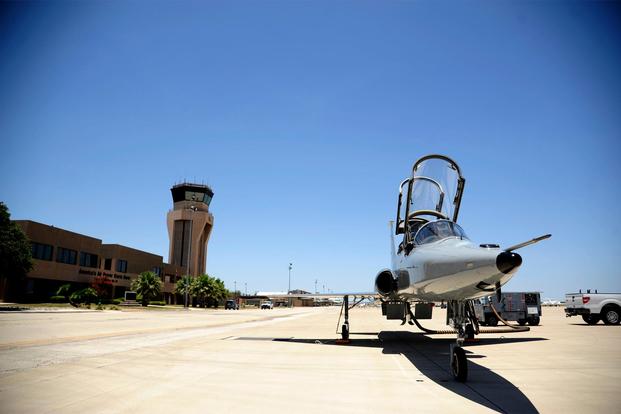Total hydraulic failure in a T-38C Talon caused the Texas-based jet trainer to crash last year, and an improperly armed ejection seat claimed the life of its pilot, according to a recently released Air Force report.
The T-38, assigned to the 87th Flying Training Squadron, had experienced a series of failures in flight before it crashed approximately 12 miles northwest of Laughlin Air Force Base Nov. 20, 2017, the Air Force Investigation Board report said.
The mishap was caused by a "dual airframe mounted gearbox failure," the report said.
"A substantial contributing factor to these gearbox failures was a lack of maintenance guidance addressing similar repeated failures of the [mishap aircraft]," it said.
Related content:
- Air Force Identifies Pilot Killed in T-38 Crash
- Laughlin AFB Suspends Flying Operations Following T-38 Crash
- Air Force Pilot Conscious After Crash near Oklahoma Base
The accident killed Capt. Paul J. Barbour, 32, who was on a requalification flight that day, the report said. Barbour was the aircrew flight equipment flight commander with the 47th Operations Support Squadron and an instructor pilot with the 87th Flying Training Squadron.
Injured in the accident was Capt. Joshua Hammervold, an instructor pilot for the 87th FTS.
Barbour, identified in the report as the mishap requalification pilot, was occupying the rear cockpit seat of the T-38, tail number 64-3213.
Approximately 20 minutes after the two pilots took off, Hammervold had deduced the trainer was experiencing "an airframe mounted gearbox failure on the left side" which caused "a loss of utility hydraulic power that is a backup to the primary flight control system," the report said.
The crew began its emergency checklist procedures, requesting an immediate return to the base.
Roughly "four minutes later while maneuvering to final approach, the [mishap crew] detected additional failed electrical systems accompanied by failure of the right airframe mounted gearbox," it said.
With both gearboxes and hydraulic pumps out, the aircraft had suffered total hydraulic failure.
The aircraft began to tilt into a nose-dive position, according to graphic renderings illustrated in the report.
The only alternative for the crew was to eject. But the crew delayed ejection as long as possible due to houses they spotted below.
"Oh man, I don't like these houses," Barbour said over his comms. "It's going to roll on us dude, we're going to have to go in a sec," Hammervold replied, as cited in the report.
Still concerned with the populated area, they delayed their ejection by another 10 seconds.
Hammervold successfully bailed out at 3:46 p.m. local time at approximately 2,500 feet above ground level.
The board, headed by Air Force Brig. Gen. Joel L. Carey, found that Barbour's seat was not properly armed because of the crew's "failure to complete the 'before takeoff checklist' item that called for the proper ejection seat system settings," the report said.
"Witness marks on the arming lever indicate the [requalification pilot] seat was in SAFE mode and not ARMED at the time of impact," the board said.
Furthermore, the rear cockpit emergency interseat sequencing system -- which, if one pilot pulls a seat, would eject both pilots in sequence -- was not properly switched into "both" mode and remained in "solo" mode, the report said.
Evidence from both the markings and crash site suggests Barbour attempted to initiate an ejection.
The gearboxes had suffered multiple failures during maintenance inspections over the last two years, the report found.
The left gearbox assembly, installed in 2016, had "five previous failures related to the gearbox;" the right gearbox, installed in 2015, had failed seven times between January 2016 up until the day of the accident, the report said.
The aircraft had multiple recurring maintenance actions on its gearboxes between January 2016 and October 2017.
According to the aircraft's maintenance forms, the aircraft itself was down for major maintenance seven times between Aug. 21, 2017 and Oct. 25, 2017.
While there was "no evidence to indicate that any of these major maintenance actions contributed to the mishap," Carey found it significant that there were repeated gearbox failures.
"The lack of maintenance guidance addressing similar repeated failures of the right gearbox was a substantial contributing factor to the mishap," he said in his conclusion.
The aircraft did not fly between Nov. 6 to Nov. 19, but had flown two mission flights earlier in the day on Nov. 20.
The aircraft was valued at $11 million, the Air Force said.
The twin-engine, high-altitude T-38 trains pilots to fly in fighter and attack aircraft such as the F-15 Eagle, F-16 Fighting Falcon, A-10 Thunderbolt and F-22 Raptor, as well as the B-1B Lancer.
In December, the service launched a $16 billion competition with the goal of building a replacement for the Northrop Grumman T-38, which entered service in 1961. Firms publicly competing for the contract -- known as the T-X program -- include Boeing Co., Lockheed Martin Corp. and Leonardo S.p.A.
-- Oriana Pawlyk can be reached at oriana.pawlyk@military.com. Follow her on Twitter at @oriana0214.










